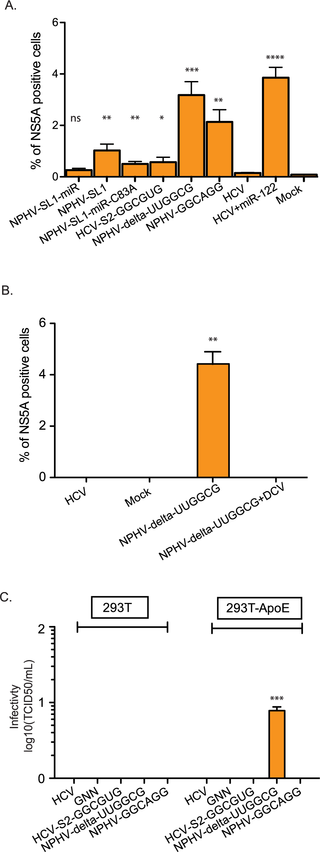PLoS Pathogens ( IF 5.5 ) Pub Date : 2017-10-30 , DOI: 10.1371/journal.ppat.1006694 Yingpu Yu 1 , Troels K H Scheel 1, 2 , Joseph M Luna 1 , Hachung Chung 1 , Eiko Nishiuchi 1 , Margaret A Scull 1 , Natalia Echeverría 1, 3 , Inna Ricardo-Lax 1 , Amit Kapoor 4, 5 , W Ian Lipkin 6 , Thomas J Divers 7 , Douglas F Antczak 8 , Bud C Tennant 7 , Charles M Rice 1

|
Hepatitis C virus (HCV) requires the liver specific micro-RNA (miRNA), miR-122, to replicate. This was considered unique among RNA viruses until recent discoveries of HCV-related hepaciviruses prompting the question of a more general miR-122 dependence. Among hepaciviruses, the closest known HCV relative is the equine non-primate hepacivirus (NPHV). Here, we used Argonaute cross-linking immunoprecipitation (AGO-CLIP) to confirm AGO binding to the single predicted miR-122 site in the NPHV 5’UTR in vivo. To study miR-122 requirements in the absence of NPHV-permissive cell culture systems, we generated infectious NPHV/HCV chimeric viruses with the 5’ end of NPHV replacing orthologous HCV sequences. These chimeras were viable even in cells lacking miR-122, although miR-122 presence enhanced virus production. No other miRNAs bound this region. By random mutagenesis, we isolated HCV variants partially dependent on miR-122 as well as robustly replicating NPHV/HCV variants completely independent of any miRNAs. These miRNA independent variants even replicate and produce infectious particles in non-hepatic cells after exogenous delivery of apolipoprotein E (ApoE). Our findings suggest that miR-122 independent HCV and NPHV variants have arisen and been sampled during evolution, yet miR-122 dependence has prevailed. We propose that hepaciviruses may use this mechanism to guarantee liver tropism and exploit the tolerogenic liver environment to avoid clearance and promote chronicity.
中文翻译:

不依赖于miRNA的肝炎病毒变异表明维持miR-122依赖性的强大进化压力
丙型肝炎病毒 (HCV) 需要肝脏特异性微小 RNA (miRNA) miR-122 才能复制。这在 RNA 病毒中被认为是独一无二的,直到最近 HCV 相关肝炎病毒的发现引发了更普遍的 miR-122 依赖性问题。在肝炎病毒中,已知与丙型肝炎病毒最接近的亲属是马非灵长类肝炎病毒(NPHV)。在这里,我们使用 Argonaute 交联免疫沉淀 (AGO-CLIP) 来确认 AGO在体内与NPHV 5'UTR 中单个预测的 miR-122 位点的结合。为了在缺乏 NPHV 允许的细胞培养系统的情况下研究 miR-122 的要求,我们生成了感染性 NPHV/HCV 嵌合病毒,其中 NPHV 的 5' 端取代了直系同源 HCV 序列。这些嵌合体即使在缺乏 miR-122 的细胞中也能存活,尽管 miR-122 的存在增强了病毒的产生。没有其他 miRNA 结合该区域。通过随机诱变,我们分离了部分依赖于 miR-122 的 HCV 变体以及完全独立于任何 miRNA 的稳健复制的 NPHV/HCV 变体。这些 miRNA 独立变体甚至在外源递送载脂蛋白 E (ApoE) 后在非肝细胞中复制并产生感染性颗粒。我们的研究结果表明,独立于 miR-122 的 HCV 和 NPHV 变体在进化过程中已经出现并被采样,但 miR-122 依赖性仍然盛行。我们认为肝炎病毒可能利用这种机制来保证肝向性并利用致耐受性的肝脏环境来避免清除并促进慢性化。











































 京公网安备 11010802027423号
京公网安备 11010802027423号